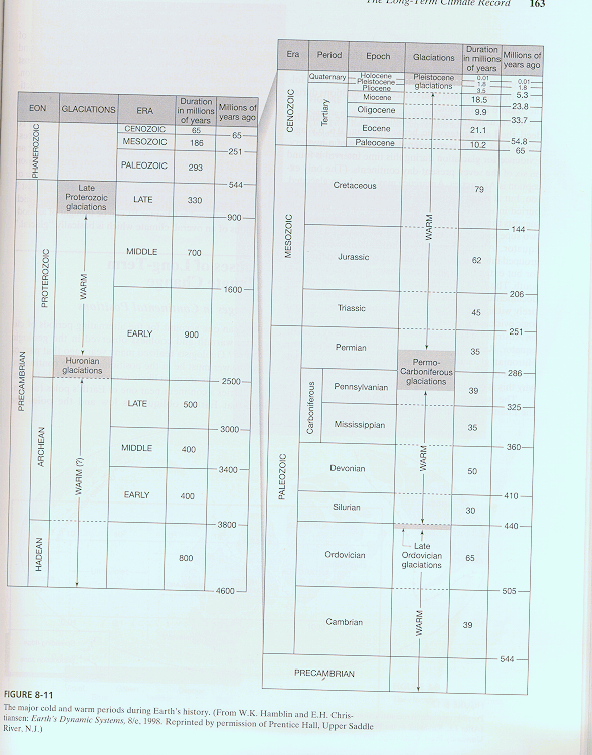History of Life on Earth
Precambrian Time
- Hadean Eon (Azoic)
1. 4.5--3.9 billion years ago Earth forms as a solid planet—no evidence of life
- Archean Eon
1. 3.9—2.5 billion years ago Earth’s permanent crust, oceans, and atmosphere are
Formed
- Earliest life forms evolve in the seas—prokaryotes (single-celled with no
(Nucleus) and cyan bacteria (blue-green algae)
- Proterozoic Eon
- 2.5 billion—540 million years ago Plate tectonics slows to same rate as present,
Large mountain ranges form, and oxygen levels increase as Earth develops ability
To obtain energy through photosynthesis
- Eukaryotes evolve (single-celled organisms with a nucleus)
- Multi-celled, soft-bodied marine organisms (metazoans) evolve
- Paleozoic Era (Ancient Life)
- Cambrian Period
- 540-490 million years ago sedimentary rocks form in shallow seas
- Multiple collisions of Earth’s plates give rise to a super continent with a mild climate
- Marine metazoans with mineralized skeletons (sponges, bryozoans, corals,
Brachiopods, mollusks, arthropods, and echinoderms) flourish
- Plant life limited to marine algae
- Ordovician Period
- 490-443 million years ago North America, Europe, and Africa emerge
- Corals, crinoids, and clams evolve as well as the first early vertebrates—
Primitive fish with bony armor plates
- Mass extinctions of marine life occur, allowing benthic (bottom-dwelling)
And plank tonic (floating, swimming) organisms to evolve
- Silurian Period
- 443—417 million years ago withdrawal of ocean beds leaves "red beds"
- Rapid evolution of suspension feeders and pelagic (open ocean) predators
- Fish develop jaws and the first sharks appear
- Earliest land plants appear as leafless, vascular psilophytes
- Devonian Period
- 417—354 million years ago Europe and North America merge with a warm,
Moist climate
- Called the Age of Fish this period is dominated by various forms of fish
- The ozone layer forms and the first air-breathing arthropods (spiders and mites) move to land
- Amphibians evolve
- Plant life, including lowland forests develop and spread over the planet
- Carboniferous Period
- 345—290 million years ago two major land masses form and the climate
Changes to cool and dry with a long interval of glaciations
- Fish continue to diversify but armored fish become extinct
- Insects flourish and the first reptiles evolve
- Land environments are dominated by plants from small shrubs to tall trees
- Permian Period
- 290—248 million years ago a single super continent forms with glaciations in
Some areas and hot, dry deserts elsewhere
- Mass extinctions occur among corals, bryozoans, and other invertebrates
- Insects evolve into modern forms; dragonflies and beetles appear
- Amphibians decline in number and reptiles undergo evolutionary development
Of various forms
III. Mesozoic Era (Middle Life)
- Triassic Period
- 248—206 million years ago the general climate is warm becoming semiarid
To arid
- Early dinosaurs form (very small compared to later forms)
- Marine reptiles evolve
- Ferns, cycads, ginkgoes, and conifers flourish
- Mass extinctions occur reducing some marine and terrestrial groups by up to
75%
- Jurassic Period
- 206—144 million years ago the Atlantic ocean begins to form
- Dinosaurs are dominant on land
- The first bird appears
- Frogs, toads, and salamanders appear
- Cretaceous Period
- 144—65 million years ago the continents are shaped much like they are today
- The global climate is warm and the poles are free of ice
- Dinosaurs peak as the dominant vertebrate life form and extend throughout
Every continent
- Early flowering plants, modern trees, and modern insects evolve
- Several mass extinctions occur including that of the Dinosaurs
IV. Cenozoic Era (Recent Life)
A. Paleocene Epoch
- 65—55 million years ago vast inland seas dry up, exposing large land areas
- Placental mammals eventually dominate the land including primates, ungulates,
Rodents, and carnivores
- Eocene Epoch
- 55—34 million years ago the Rockies and Alpine-Himalayan mountain systems
Form
- The climate is subtropical and moist throughout North America and Europe
- Early forms of horse, rhinoceros, camel, and bats evolve
- Oligocene Epoch
- 34—24 million years ago the climate is generally temperate with glaciations
Beginning in Antarctica
- Modern mammals become dominant vertebrate life forms and many archaic
Mammals become extinct
- Grasslands expand and forest regions diminish
- Miocene Epoch
- 24-5 million years ago ocean currents are established, the climate cools, and
Antarctica becomes permanently frozen
- Almost half of all modern placental mammal families are present
- Almost all modern whale groups are present
- Many modern birds—herons, ducks, eagles, hawks, crows, and sparrows are
Present
- Pliocene Epoch
- 5—1.8 million years ago the Sierra Nevada and Cascade Mountains are formed
- Climate becomes drier and cooler
- Primates continue to evolve
- Quaternary Period
A. Pleistocene Epoch
- 1.8 million—10,000 years ago known as the Great Ice Age
- As much as 30% of the Earth’s surface is covered by glaciers
- The oldest species of Homo—Homo habilis—evolves
- Mammalian evolution includes the development of large forms
- Large mammals such as horses, camels, and mammoths
- Holocene Epoch
- 10,000 years ago—present the glaciers retreat, climate warms, and deserts
Form in some areas
- Homo sapiens evolve and human civilization develops
- Human activity begins to affect world climate
- Other species continue to become extinct


